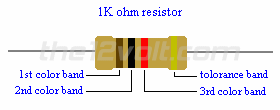

Resistors "resist" the flow of electrical current. The higher the value of resistance (measured in ohms) the lower the current will be.
Resistors are color coded. There are three color bands, one multiplier band, and one tolerance band. To read the color code of a common 4 band 1K ohm resistor with a 5% tolerance, start at the opposite side of the GOLD tolerance band and read from left to right. Write down the corresponding number from the color chart below for the 1st color band (BROWN). To the right of that number, write the corresponding number for the 2nd band (BLACK) . Now multiply that number (you should have 10) by the corresponding multiplier number of the 3rd band (RED)(100). Your answer will be 1000 or 1K. It's that easy.
* If a resistor has 5 color bands, write the corresponding number of the 3rd band to the right of the 2nd before you multiply by the corresponding number of the multiplier band. If you only have 4 color bands that include a tolerance band, ignore this column and go straight to the multiplier.
The tolerance band is usually gold or silver, but some may have none. Because resistors are not the exact value as indicated by the color bands, manufactures have included a tolorance color band to indicate the accuracy of the resistor. Gold band indicates the resistor is within 5% of what is indicated. Silver = 10% and None = 20%. Others are shown in the chart below. The 1K ohm resistor in the example (left), may have an actual measurement any where from 950 ohms to 1050 ohms.
If a resistor does not have a tolerance band, start from the band closest to a lead. This will be the 1st band. If you are unable to read the color bands, then you'll have to use your multimeter. Be sure to zero it out first!
|
||||||||||||||||||||||||||||||||||||||||||||||||||||||||||||||||||||||||||||||||||||||||||||






























